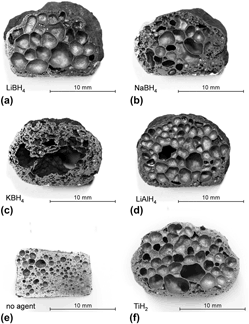Crossref Citations
This article has been cited by the following publications. This list is generated based on data provided by
Crossref.
Banhart, J.
Vinod-Kumar, G.S.
Kamm, P.H.
Neu, T.R.
and
García-Moreno, F.
2016.
Light-metal foams: Some recent developments.
Ciência & Tecnologia dos Materiais,
Vol. 28,
Issue. 1,
p.
1.
Banhart, John
2018.
Comprehensive Composite Materials II.
p.
347.
Muduli, B.
Ramesh, T.
Hari Kumar, K.C.
Rajalakshmi, N.
and
Mukherjee, M.
2019.
Customised heat treatment of TiH2 for the foaming of aluminium alloys.
Materialia,
Vol. 8,
Issue. ,
p.
100431.
Pamidi, Venkat
Muduli, Biswaranjan
and
Mukherjee, Manas
2020.
Al and Al-TiB2 Foams Produced by Melt Injection Technique.
Transactions of the Indian Institute of Metals,
Vol. 73,
Issue. 1,
p.
191.
Barode, Jayant
Aravind, U.
Bhogi, Santhoshkumar
Muduli, Biswaranjan
and
Mukherjee, Manas
2021.
Mg and Mg-Based Blowing Agents for Aluminum Foam.
Metallurgical and Materials Transactions B,
Vol. 52,
Issue. 1,
p.
292.
García-Moreno, Francisco
and
Banhart, John
2021.
Influence of Gas Pressure and Blowing Agent Content on the Formation of Aluminum Alloy Foam.
Advanced Engineering Materials,
Vol. 23,
Issue. 10,
Kamm, Paul Hans
Neu, Tillmann Robert
García-Moreno, Francisco
and
Banhart, John
2021.
Nucleation and growth of gas bubbles in AlSi8Mg4 foam investigated by X-ray tomoscopy.
Acta Materialia,
Vol. 206,
Issue. ,
p.
116583.
Kashid, Anandarao
Patil, Abhijit
and
Kashid, Shubhangi
2023.
Characterization of AlSi10Cu2 Aluminium Alloy Manufactured by Centrifugal Casting Route.
p.
1.
Behymer, Nathan
and
Morsi, K.
2023.
Review: Closed-Cell Metallic Foams Produced via Powder Metallurgy.
Metals,
Vol. 13,
Issue. 5,
p.
959.
Murali, Arun Prasad
Duraisamy, Sivaprahasam
Samuthiram, Sasikumar
and
Vijay, R.
2024.
Current and emerging methods for manufacturing of closed pore metal foams and its characteristics: a review.
Journal of Materials Science,
Madgule, Mahadev
CG, Sreenivasa
Patel GC, Manjunath
L, Avinash
Singhal, Piyush
Pandit, Dhiren
and
Malik, Vinayak
2024.
Influence of foaming agents on mechanical and microstructure characterization of AA6061 metal foams.
Proceedings of the Institution of Mechanical Engineers, Part E: Journal of Process Mechanical Engineering,
Vol. 238,
Issue. 2,
p.
520.
Fu, Wensheng
and
Li, Yanxiang
2024.
Fabrication, Processing, Properties, and Applications of Closed-Cell Aluminum Foams: A Review.
Materials,
Vol. 17,
Issue. 3,
p.
560.
Rodinger, Tomislav
Ćorić, Danko
and
Kováčik, Jaroslav
2024.
The Effect of Foaming Agents on the Thermal Behavior of Aluminum Precursors.
Materials,
Vol. 17,
Issue. 3,
p.
710.



